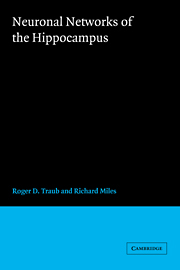Book contents
- Frontmatter
- Contents
- Acknowledgments
- Prologue
- 1 The hippocampus in context
- 2 Physiology of single neurons: voltage- and ligand-gated ionic channels
- 3 Synaptic function and organization of the CA3 region
- 4 The single-cell model
- 5 Model of the CA3 network
- 6 Collective behaviors of the CA3 network: experiment and model
- 7 Collective behaviors of the CA3 network: spontaneous oscillations and synchronized synaptic potentials
- 8 Field effects
- 9 Theoretical approaches: mathematical neural networks
- Conclusion
- Notes
- References
- Index
7 - Collective behaviors of the CA3 network: spontaneous oscillations and synchronized synaptic potentials
Published online by Cambridge University Press: 05 February 2012
- Frontmatter
- Contents
- Acknowledgments
- Prologue
- 1 The hippocampus in context
- 2 Physiology of single neurons: voltage- and ligand-gated ionic channels
- 3 Synaptic function and organization of the CA3 region
- 4 The single-cell model
- 5 Model of the CA3 network
- 6 Collective behaviors of the CA3 network: experiment and model
- 7 Collective behaviors of the CA3 network: spontaneous oscillations and synchronized synaptic potentials
- 8 Field effects
- 9 Theoretical approaches: mathematical neural networks
- Conclusion
- Notes
- References
- Index
Summary
Oscillatory synchronous neuronal population behaviors are generated in many parts of the mammalian brain. Such behaviors underlie rhythmical EEG waves in the cortex. Some other brain regions wherein repeating population events occur, with many of the cells firing synchronously, include the brain-stem respiratory pattern generator (Feldman and Ellenberger, 1988), various brain-stem nuclei during pontine-geniculooccipital waves (PGO waves, an EEG correlate of REM sleep) (Steriade et al., 1989), the thalamus during spindle waves (Steriade and Llinás, 1988), and pools of motoneurons during swimming (Wallen et al., 1985) or during eye movements.
It is important to understand population oscillations, for several reasons. First, rhythmic population activities form the background “blackboard” on which afferent, associative, and motor activities must be written (Arieli and Grinvald, 1988; Eckhorn et al., 1988; Gray and Singer, 1989); see also the section on theta rhythm in Chapter 1. Understanding the initiation and synchronization of waves of activity in any one of these cases may shed light on underlying mechanisms in the others. Second, we would like to know the factors that determine the amplitude and period of the oscillation. Does each cell oscillate at the same frequency as the population? Can the frequency of the population behavior be inferred from the intrinsic properties of the cells (Llinás, 1988), or is population rhythmicity an emergent property that cannot be inferred from a single cell?
Information
- Type
- Chapter
- Information
- Neuronal Networks of the Hippocampus , pp. 157 - 193Publisher: Cambridge University PressPrint publication year: 1991
Accessibility standard: Unknown
- 1
- Cited by
